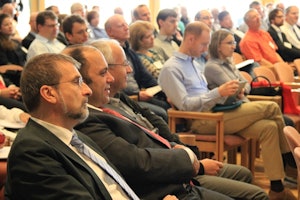
Across Europe, managers and staff in radiology departments, as well as their clinical peers, are facing a desperate need for dynamic scheduling and transparency regarding available resources. At the 16th DICOM Meeting and HIS-RIS-PACS workshop, held last week in Mainz, Germany, details of a dashboard solution were presented.
 Clemens Schilz has a degree in physical technology from the Aachen Technical University in Germany. After four years working in applied informatics at Trier University, in 2001 he joined Barmherzige Brüder Hospital in Trier where he is responsible for IT systems and applications in the imaging center.
Clemens Schilz has a degree in physical technology from the Aachen Technical University in Germany. After four years working in applied informatics at Trier University, in 2001 he joined Barmherzige Brüder Hospital in Trier where he is responsible for IT systems and applications in the imaging center.Trier, a city of approximately 100,000 residents, is situated near the German-Luxembourg border. Two hospitals dominate most of the local market, one being the Barmherzige Brüder Hospital. Clemens Schilz is responsible for IT systems and applications in the imaging center covering radiology, neuroradiology, sonography, and nuclear medicine. He has created an IT package that aims to improve scheduling and resource management.
At Barmherzige Brüder, the department centralizes all imaging activities, except for cardiology and endoscopy, across the acute care hospital and a connected physicians' center. This includes all sonography examinations, carried out in seven rooms. The department serves about 35,000 patients annually and is characterized by a unified management and a homogeneous IT applications structure. Until a few years ago, scheduling of the sonography cases was done conventionally using a whiteboard, but this approach was cumbersome.
"With worklists of up to 100 patients, scheduling was a challenging task," Schilz explained. "The qualification status of physicians differs, which means patients have to be matched with physician competence -- for example, a specific physician may be eligible to do abdominal sonograms, but no vascular cases. Adherence to scheduling was below optimum, and patient waiting times were too long."
In 2007, sonography was centralized campus-wide in the imaging center, and the worklist produced by the RIS was monodimensional and did not offer sufficient information and functionality. At Barmherzige Brüder, Integrating the Healthcare Enterprise (IHE) Scheduled Workflow could not be realized because the status information could not be communicated back to the hospital information system (HIS) due to an interface issue. Schilz was asked to program anapplication to cope with this situation.
 The annual DICOM Meeting and HIS-RIS-PACS workshop, organized by Mainz University Medicine and the IT Working Group of the German Radiological Society (DRG), brings together researchers, users, consultants, and IT vendors. It is a key event in the German-speaking radiology IT community. The late June 2014 meeting attracted approximately 280 attendees.
The annual DICOM Meeting and HIS-RIS-PACS workshop, organized by Mainz University Medicine and the IT Working Group of the German Radiological Society (DRG), brings together researchers, users, consultants, and IT vendors. It is a key event in the German-speaking radiology IT community. The late June 2014 meeting attracted approximately 280 attendees.The system that emerged, and was implemented, over time integrates further modalities such as MRI and CT. For these patients, information about the preparation status can be added. The dashboard is the primary system used for scheduling in the imaging center; in the clinical departments, the viewer is used as an additional tool that provides an overview of the schedule and of completed exams. Clinicians can judge availability of resources for the rest of the day, and the time patients have spent waiting is visible, so long waits can be avoided. The software is programmed in HTML and is browser-based, with an intuitive user interface. On a Linux server, websites are generated by PerlScript and distributed using ApachePerl and Oracle modules. These websites can be accessed via the HIS. No installation is required on the client side.
"Users love this system," he said. "It helps radiologists and clinicians meet challenges in their daily routine."
The solution is evolving continuously, with additional features integrated on the way. Schilz said he is happy to discuss the dashboard, and possibly make it available to the community.



















